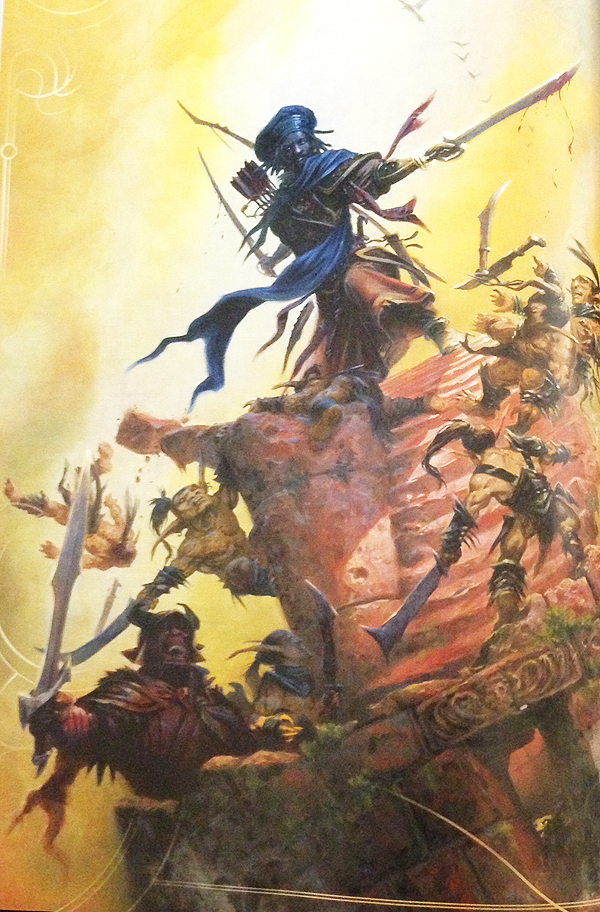The Dungeons & Dragons Player’s Handbook was released to Advanced Wizard Play Network Stores on August 8, 2014.
This marks the second major release for the current iteration for D&D with the boxed Starter Set first released in July.
I really didn’t have any intention of buying any more of the releases for 5th edition, but the boxed set left me with a good impression that I decided to purchase the Player’s Handbook.
There will be a lot of detailed reviews on the book on the web, so I thought I would post a few thoughts and some pics of the book.
The Dungeons and Dragons Player’s Handbook is a hardcover 316-page book that covers the creation of characters for the D&D game, and it’s a great read for people new to tabletop roleplaying games and players returning to the game.
The book is written so that if you’re unfamiliar with D&D and RPGs in general, you’ll be able to understand the rules not only for character creation but the overall concepts of the game as well, such as combat and skills.
For those returning to the game, like myself, you’ll enjoy the more streamlined take on the game rules (especially ability scores and how they relate to combat) and some fun new mechanics like advantage and disadvantage where you roll two dice and either take the high roll or low roll depending on your character’s situation.
The book is broken down into three sections which focus on character creation, skills and combat, and spellcasting and spells.
Players could choose from nine major races including the human, elf, dwarf, tiefling and gnome with each race having specific bonuses and special abilities like the dragonborn’s breath weapon (!).
There are 12 character classes or vocations that include all the familiar ones from past D&D incarnations like the fighter, cleric, monk, paladin, ranger and wizard.
When I first started playing D&D in 2006, I equally enjoyed crafting a character and playing in a game, since both provide you a variety of interesting options to choose from, and some unexpected choices you may make from a discovery.
The D&D Player’s Handbook carries on this tradition with its choices to create characters that have been in your head since the announcement of the book, and characters that you think of when reading the book and seeing some of the stunning art work.
One of the best art production features in the book is the full page art spreads. The art pieces, spread throughout the book, not only help to bring the reader into the world of D&D, but give inspiration to the characters you create.
The first character I created from the book was the barbarian; it was a character class I for one reason or another never chose in the past, but decided to experiment with.
But in the process of creating him, I read through the descriptions of the bard (a character class I would have never ever considered), saw the accompanying artwork, and immediately knew I had to create another character.
The process to create a character is broken down well with the book providing step-by-step instructions to get a basic idea turned into a well-formed and detailed character ready to explore the world of D&D.

My favorite of the full page art spreads from the 5th edition of the Dungeons and Dragons Player’s Handbook.

A couple pages on gear and weapons from the 5th edition of the Dungeons and Dragons Player’s Handbook.
One of the most noticeable differences, and a change gladly accepted by me, is a move away from the more detailed tactical rules of combat that were found in the 3rd edition Player’s Handbook which used maps and miniatures to show line of sight, movements, diagonal movement, 5-foot step, etc., etc., etc.
In 5th edition, there’s now one short block of information in the combat section that gives some basic rules IF you want to play using a grid. That’s it.
I know a few people I played with that enjoyed the more detailed nuances of 3rd edition’s combat, but I felt it slowed the pace of the game, and I more than welcome 5th edition’s smoother take.
The book also has a pretty comprehensive section on spellcasting, which may push you away from playing fighters and rogues, with pages containing an abundance of impressive and formidable spells to choose from like the “Cloud of Daggers” or “True Resurrection.”
I already had a pretty good idea of what to expect from the Player’s Handbook because of all the coverage on the release as well as reading, and playing in a session from the Starter Set.
But I was pleasantly surprised to find some new ideas and characters that I never knew existed until I opened this book.









Leave a comment